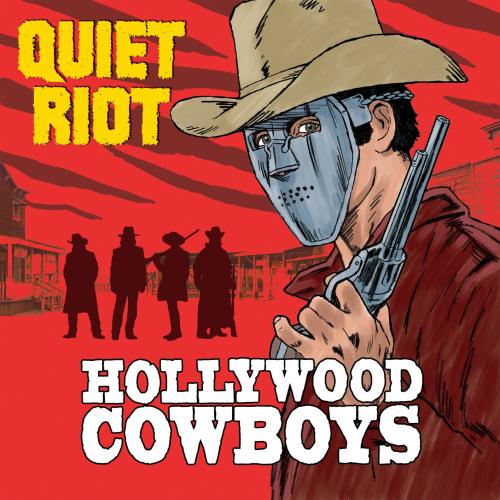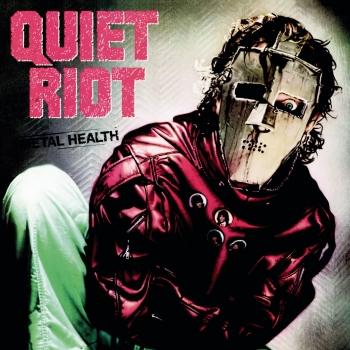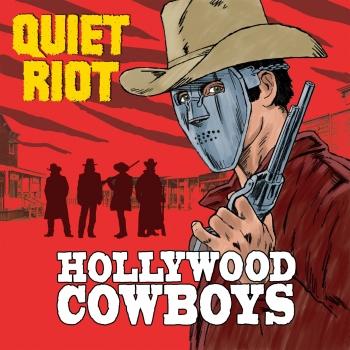
Hollywood Cowboys Quiet Riot
Album info
Album-Release:
2019
HRA-Release:
08.11.2019
Album including Album cover
I`m sorry!
Dear HIGHRESAUDIO Visitor,
due to territorial constraints and also different releases dates in each country you currently can`t purchase this album. We are updating our release dates twice a week. So, please feel free to check from time-to-time, if the album is available for your country.
We suggest, that you bookmark the album and use our Short List function.
Thank you for your understanding and patience.
Yours sincerely, HIGHRESAUDIO
- 1 Don't Call It Love 04:05
- 2 In the Blood 03:28
- 3 Heartbreak City 04:15
- 4 The Devil That You Know 02:40
- 5 Change or Die 03:23
- 6 Roll On 05:54
- 7 Insanity 04:44
- 8 Hellbender 03:20
- 9 Wild Horses 03:10
- 10 Holding On 04:23
- 11 Last Outcast 02:35
- 12 Arrows and Angels 02:56
Info for Hollywood Cowboys
Quiet Riot ist ein Rock & Roll-Phänomen. Das Los Angeles Quartett, das als erste Heavy-Metal-Band an der Spitze der US-Pop-Charts bekannt ist, wurde durch sein gigantisches Smash-Hit-Album "Metal Health"; von 1983 zu einer Weltsensation. Dieses Album lag mehrere Monate lang an der Spitze der Billboard-Album-Charts und das Folgealbum "Condition Critical"; wurde mit Doppelplatin ausgezeichnet. Die Band hat weiterhin aufgenommen (insgesamt 11 Studioalben) und tourt durch ihre 30-jährige Geschichte.
Quiet Riot setzt ihre historische Reise mit Gründungsmitglied und Schlagzeuger Frankie Banali fort, zu dem auch der erfahrene Bassist Chuck Wright (der seit 1982 in der Band ist und aus ihr ausscheidet) und der Gitarrist Alex Grossi (der seit 2004 in der Band ist) kommen. Mit ihrer neuesten Veröffentlichung "Road Rage"; stellte Quiet Riot dem Fan den Kraftpaket-Sänger James Durbin vor, der in der elften Stunde eintrat, um den neuen Songs seinen Stempel aufzudrücken.
Mit "Hollywood Cowboys"; übernimmt James endlich die volle Kontrolle und wird jeden mit seinem erstaunlichen Pfeifensatz in die Luft jagen. Frankie Banali's Geschichte mit QUIET RIOT erstreckt sich über 34 Jahre und er hat die Ehre, das einzige Mitglied von Quiet Riot zu sein, das bei jeder einzelnen Quiet Riot-Veröffentlichung aufgenommen hat. Nach fast zehn Jahren seit dem Verlust seines Freundes und Mitbegründers und Bandkollegen Kevin DuBrow, und mit sorgfältiger Überlegung, Seelensuche und mit dem Segen und der Unterstützung von Kevin DuBrows Familie, ist Frankie mit der Band vorangekommen, um den Fans eine neue Platte zu bringen! Musikalisch bietet das neue Album genau das, was man von Quiet Riot erwarten würde. Arena-fähiger Hardrock mit starken Hooks und ansteckenden Riffs, verbunden mit einer Reife im Songwriting, die nur eine Band mit einer solchen Geschichte und Abstammung bieten kann.
Quiet Riot sind stärker denn je zurückgekehrt, in perfect METAL HEALTH mit dem neuen Album: " Hollywood Cowboys";! Erlebe sie diesen Sommer auf der Straße!
Quiet Riot
Quiet Riot
For a very brief moment, Quiet Riot was a rock & roll phenomenon. Famously described as the first heavy metal band to top the pop chart (a claim that greatly depends on one's exact definition of heavy metal), the Los Angeles quartet became an overnight sensation thanks to their monster 1983 smash album Metal Health. But Quiet Riot's road to success had in fact been long and arduous, and when their star power subsequently began to fade, their fall from grace was ironically accelerated by the man who was most responsible for taking them to the top: singer Kevin DuBrow. Unable to suppress his infamous motor mouth from assaulting many of Quiet Riot's peers, DuBrow gradually alienated his fans and fellow musicians, and in the face of plummeting record sales, faced the iniquity of being fired from his own band. The dust eventually settled and DuBrow was able to resurrect Quiet Riot in the '90s, but despite their best efforts, the once chart-topping band would remain forever exiled to the fringes of pop conscience, and what might once have been a full chapter in rock history has instead become little more than a footnote.
The story of Quiet Riot began with vocalist Kevin DuBrow and guitarist Randy Rhoads, who started the band in 1975 after disbanding an earlier project named Violet Fox, and completed their first lineup with bassist Kelli Garni and drummer Drew Forsyth. Along with local scene contemporaries like Van Halen, Xciter, and London, the band thrilled audiences packing the L.A. nightclubs, but found it difficult to land a record deal during the disco-dominated late '70s. Eventually securing a contract with Columbia Records in Japan, they recorded two moderately successful albums -- a 1978 eponymous debut and 1979's Quiet Riot II, featuring new bassist Rudy Sarzo -- before losing Rhoads (and later Sarzo) to Ozzy Osbourne's band (and later a tragic plane accident, rock & roll martyrdom, immortality, etc.).
Quiet Riot disbanded and DuBrow formed a new band under his own name, working with several musicians over the next few years before signing with independent Pasha Records, reverting to the Quiet Riot moniker, and entering the studio with new guitarist Carlos Cavazo and bassist Chuck Wright to start work on a new album. The year was 1982, and, following Randy Rhoads' well-documented demise, former henchman Sarzo quit Ozzy, pushed Wright out of the way, and brought friend and drummer Frankie Banali into the fold to complete the lineup and sessions for what would become 1983's Metal Health. Driven by the irresistible double whammy of the title track's muscular bassline (reputedly played by Wright before his dismissal) and a raucous rendition of the old Slade chestnut "Cum on Feel the Noize," the album stormed up the U.S. charts, duly reaching the number one spot and going platinum five times over in the process. Their unexpected success shocked everyone, not least the bandmembers, who found it pretty hard to cope with sudden stardom and the pitfalls that came with it.
Condition Critical Pressured to capitalize on their hot streak, Quiet Riot was rushed back into the studio to whip together 1984's Condition Critical, but unsurprisingly, the album was little more than a weak carbon copy of Metal Health -- even sinking so low as to include another chart-ready Slade cover in "Mama Weer All Crazee Now." Fans were unimpressed, and panic set in as the band watched the record quickly sliding off the charts to make way for fresher, up-and-coming L.A. glam metal contenders like Mötley Crüe and Ratt. An incensed DuBrow went on a rampage, incessantly slagging fellow metal bands, members of the press, and his own record company, in the process quite literally burning most every bridge he'd worked so hard to build. The abusive behavior also began wearing on his bandmates, and by the time they re-grouped to launch a comeback with 1986's QR III, Sarzo was long gone (later joining Whitesnake) and had been replaced by former bassist Chuck Wright, most recently working with Giuffria.
Hysteria A failed experiment in ultra-glossy '80s metal, QR III was a third-rate Hysteria possessing none of its predecessor's blue-collar grit and became an even bigger flop, sending Quiet Riot into an irreversible tailspin. Mounting tension resulted in an all-out band mutiny at tour's end, with DuBrow finding himself abandoned at a hotel in Hawaii, while the remaining musicians and crew left on an earlier flight back to L.A. Furious, he watched in disbelief from the sidelines as Rough Cutt vocalist Paul Shortino stepped into his shoes and recorded 1988's simply named Quiet Riot with Cavazo, Banali, and new bassist Sean McNabb. The album's absolutely abysmal sales offered little consolation, and DuBrow finally gave up on diplomacy and filed an injunction against his former colleagues (apparently he still owned rights to the name), successfully bringing Quiet Riot to a stuttering halt. Frankie Banali said "good riddance" and jumped ship to join L.A. shock-metal kings W.A.S.P., while the remaining bandmembers went to ground.
Terrified Then, come 1991, DuBrow and Cavazo began working together once again in a band called Heat. In time, they began using the Quiet Riot name once again, eventually recording 1993's Terrified with bassist Kenny Hillery and a returning Banali. Down to the Bone followed two years later, and in 1997, a one-off performance at a party hosted by industrial shock rocker Marilyn Manson lured bassist Rudy Sarzo back to the fold. With their classic lineup intact once again, a re-energized Quiet Riot hit the road playing clubs across America. Public response was less than enthusiastic, however, and the band usually couldn't get arrested -- except for DuBrow, who spent a night in jail after a tour stop in Charlotte, North Carolina, where an irate fan had sued him for injuries sustained at a previous show. This and other roadside misadventures were captured on 1999's optimistically named Alive and Well live album, and 2001 saw the release of Guilty Pleasures, the first recording by the band's classic lineup in 17 years. Unfortunately, said album wasn't able to capture lightning in a bottle for a second time, and Quiet Riot quietly broke up shortly thereafter.
Rehab Unwilling to put the band to rest, DuBrow and Banali recruited guitarist Neil Citron and bassist Tony Franklin for the recording of Rehab in 2006. Sadly, at age 52, DuBrow's singing career was cut short from a cocaine overdose. His body was found in his Las Vegas apartment on November 25, 2007. In 2010, Banali revived the band alongside lead vocalist Mark Huff, bassist Chuck Wright, and guitarist Alex Grossi. Love/Hate vocalist Jizzy Pearl joined the lineup in 2013, and the following year the group released Quiet Riot 10, a new studio album that included four live tracks that had been recorded during Dubrow's final stretch of performances with the group. Road Rage, the band's 13th long-player and first outing for new vocalist and former American Idol contestant James Durbin and Frontiers Records, followed in 2017. (Source: Eduardo Rivadavia, AMG)
This album contains no booklet.














